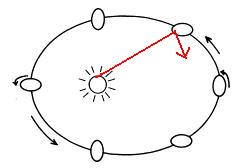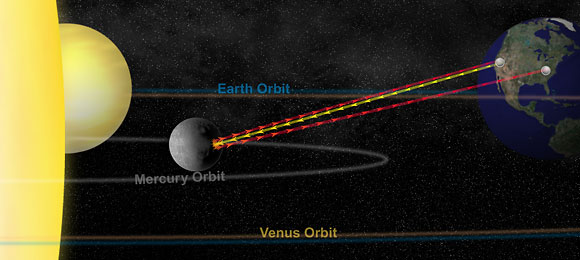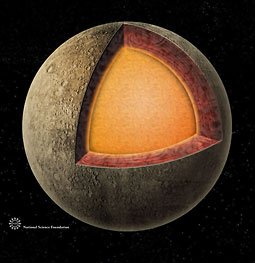Mercury's rotation is studied at the Royal Observatory of Belgium, especially the spin-orbit resonance and libration. Knowledge of these phenomena and their observations will help to resolve some issues on Mercury, such as "How is its internal structure?".
The spin-orbit resonance
The revolution of Mercury around the Sun takes 87.969 Earth days. The diurnal rotation period is 58.646 Earth days. It happens that this period is exactly equal to 2/3 of the revolution of Mercury around the Sun. Mercury rotates three times on itself while it revolves twice around the Sun, this is called the 3/2 spin-orbit
resonance. Mercury is the only planet in asynchronous resonance (i.e. in a report of integers that is not 1/1). In 1889, Schiaparelli said that the period of diurnal rotation of Mercury was 87.969 Earth days. Indeed, after several years of observation of Mercury, he had noticed that the planet presented always the same face to the Sun, like the Moon with the Earth. He concluded that Mercury was synchronized with the Sun. This erroneous conclusion was due to the fact that every time that Mercury was placed to be observed, it presented the same face. This is always the case for the resonance 3/2, but this would also be the case if Mercury was also totally synchronized with the Sun. The error of observation is due to the 6:4:3 resonance between
synodic, orbital and rotation periods of Mercury. In the sixties, scientists began to observe Mercury with radars ; the temperatures of the surface supposed to be always in the shadow were too important for never being exposed to the Sun. In 1975, the probe
Mariner 10 made measurements with a better accuracy reporting a period of diurnal rotation of 58.646 Earth days.
The librations
The librations of Mercury are the small regular oscillations of the panet on its axis of rotation. They are mainly due to the flattening of Mercury, its rotation on itself and the
eccentricity of its orbit. Kepler's laws tell us that the speed of a planet varies according to its location on the orbit; the more it is near the Sun, the most important is its speed. In the case of Mercury, the eccentricity is important and there are thus significant speed variations during the revolution around the Sun. The equatorial bulge is not always aligned in the direction of the Sun, causing a restoring force and a libration. The period of Mercury's main libration is equal to 88 days and its amplitude is about 35
arc seconds which is equivalent to a displacement of 400 meters on the surface at the equator.

|
There are two other types of libration: the free libration, and the forced librations due to the presence of Venus and Jupiter.
The study of the amplitude of those librations is extremely interesting because it depends on the state of the core. This dependence has been highlighted by Peale in 1976. Since then, they were measured by the team of Jean-Luc Margot in 2007 and the BepiColombo probe will measure it with an accuracy even more important. View this phenomenon.
|
|
The librations of Mercury
|
Peale's experiment
Peale discovered in 1976 a formula which provides properties of the internal structure of Mercury from the measurement of certain characteristics (parameters C
20 and C
22 describing part of the gravitational field, the obliquity, and the amplitude of the libration). Indeed, it allows to calculate the value of
moments of inertia of the planet: A, B, C and C
m.
Let's detail those parameters:
- The obliquity is the angle between the axis of rotation of Mercury and the perpendicular to its orbital plane
- The amplitude of libration is the size of the oscillations of Mercury on its axis of rotation
- C20 and C22 are parameters that characterize the gravitational field; they measure the mass distribution within Mercury and the flattening of the planet in all directions (equatorial flattening and polar flattening), the more their absolute value is important, the more the planet is flattened.
- A, B and C are the moments of inertia of the planet. Cm is the polar moment of inertia of the mantle, Ccore is the polar moment of inertia of the core and C is the moment of inertia of the entire planet, with C being the sum of Cm and Ccore.
If the core is liquid C
m / C is 0.5 and if it' is solid C
m / C is 1. With the Peale formula, one can determine the value of C
m / C.
Other formulas allow us to express A, B and C according to C
20, C
22 and the amplitude of libration.
f(e) is a function of the orbital
eccentricity of Mercury
φ is the amplitude of the libration
ε is the amplitude of the obliquity.
The MORE (Mercury Orbiter Radioscience Experiment) experiment of BepiColombo will measure the precise value of C
20, C
22. The amplitude of the libration and obliquity will be deducted from the MORE Geodetic experiment, in conjunction with the use of the camera and the star-tracker, which will allow to obtain the orientation of the spacecraft relative to the stars. Peale's experiment will reveal the state of the core.
|
The radar observations
In 2007, Jean-Luc Margot and his team have studied the libration of Mercury and observed the planet with a radar. These researchers use large telescopes to measure changes in Mercury's diurnal rotation motion. They send a powerful radar signal from Earth and recover the echo with two telescopes. They measure the time taken between the reception of the signal at the two different locations. This technique (Radar Speckle Displacement Interferometry RSDI) allows them to compute the rotation of Mercury, its obliquity: 126.6 seconds ± 6 arc seconds and its libration amplitude of 35 arc seconds ± 2 arc seconds. The libration amplitude is two times higher than what they expected for a solid body. The measured value can be appropriate for a planet with a liquid core, because it is not forced to follow the solid mantle in its rotation.
A small planet like Mercury should have cooled quickly, the core should have "frozen" a long time ago.
|

|

|
|
Jean-Luc Margot's experiments
(credits: http://www.news.cornell.edu
/stories/May07/margot.mercury.html
and NASA)
|
|
To maintain a liquid core for billions of years, we need the presence of a light element, such as sulfur, in the mixture of iron within the core. This mixture lowers the temperature of solidification of the core compared to that of pure iron. The core can therefore remain liquid longer than if it was in pure iron. Jean-Luc Margot concludes from his observations that one can say with 90% certainty that Mercury has a liquid core.





